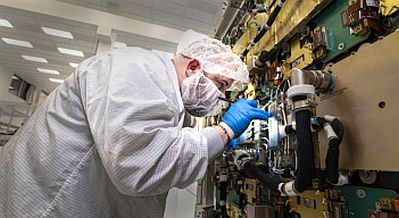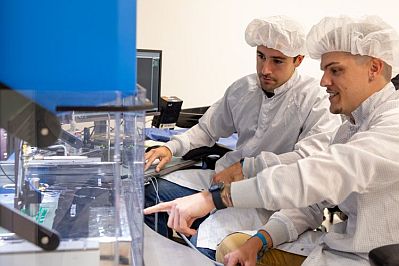The Manufacturing Space Race
The speed of getting to space relies on more than just the thrust of a rocket. Before any countdown begins, satellite systems must be designed, manufactured and tested to ensure they meet the unique needs of each mission. Northrop Grumman's latest solutions, from well-crafted payloads to configurable high-volume constellations, are delivering on the mission to help keep the nation safe.
The pace required to meet rapidly evolving threats require solutions to be in orbit faster than ever. What once took years must now take months -- but this change doesn't happen overnight.

Space payloads manufactured through progressive assembly processes support high-speed and -volume production needs. [Photo Credit: Northrop Grumman]
Northrop Grumman's manufacturing infrastructure and digital ecosystem focus on program execution, bringing together employees, customers and suppliers seamlessly into an integrated environment. This accelerates design, integration, testing and deployment across programs, ensuring readiness to deliver space systems on orbit at the speed of relevance.
"Priority shifts in the space domain have required high-volume satellites on shortened timelines," said Murali Krishnan, Vice President and General Manager, Payload and Ground Systems, Northrop Grumman. "With significant investments in how we manufacture, and a close partnership with our customer, we've been able to do both."
Making Space for High-Volume Manufacturing
In a pristine, high-bay cleanroom manufacturing hub, the constant hum of a high-efficiency air filtration system is pierced by the sound of engineers assembling space payload panels a dozen at a time through additive manufacturing processes along a progressive assembly line.
These are the sounds of Northrop Grumman's Maryland Space Assembly and Test (MSAT) center, where the company is creating a new generation of space intelligence, surveillance and reconnaissance payloads to support missions protecting and defending the security of the United States and its allies.
By leveraging advanced manufacturing processes across the company, the center develops and delivers space payloads in an assembly line-like environment.
Northrop Grumman Production Director Nick Watkins has seen the results of leveraging advanced manufacturing techniques firsthand. "With our progressive line, we have evolved from building one or two mission payloads over a few years to more than 10 times that," he said. "The progressive assembly, manufacturing and test environment enable us to produce and deliver capabilities magnitudes faster than before."

High-speed robotics like RoBob take on repetitive manufacturing processes and allow engineers to focus on further delivering capabilities. [Photo Credit: Northrop Grumman]
Human engineering prowess is enhanced with the addition of high-speed robotics. RoBob, named after a longtime Northrop Grumman engineer, is a commercially driven platform able to perform repeat assembly processes in a fraction of the time.
The MSAT center features unique testing capabilities to allow larger payloads to be subjected to the harsh environment of space just steps away from the manufacturing line in greater quantities.
Space Autoline Technologies
Development timelines of MSAT satellites are further accelerated by applying the same automated manufacturing processes to the component and circuit board levels, which serve as the building blocks of each payload.
Many of these critical pieces begin their development journey in the Space Autoline Technologies (SALT) center in Elkridge, Maryland, which is the newest addition to Northrop Grumman's advanced space manufacturing facilities. With more than 78,000 square feet of new production space, SALT expands production capability down to the building-block level.
Utilizing a digitally integrated manufacturing environment, each step of the development process is closely monitored and coordinated. Space bonding and coating, workbenches and thermal and vibration test capabilities deliver systems quickly and efficiently while keeping everything under one roof. Co-locating these steps removes the need to move hardware to a variety of disconnected locations.

Engineers at Northrop Grumman's SALT facility leverage high-precision manufacturing hardware for rapid payload component assembly while maintaining a quality edge. [Photo Credit: Northrop Grumman]
"When space hardware exits this facility, it is directly incorporated into the next higher assembly," Watkins said. "Bringing assembly and test into a centralized advanced manufacturing center saves time, reduces cost and decreases the risk of damage."
Across both SALT and MSAT, shop floor augmented reality (AR) tools provide enhanced support to engineers allowing them to see detailed designs up close. 3D overlays of manufacturing information in the point of view of the user allow them to work more efficiently while decreasing opportunities for error. Incorporating AR into Northrop Grumman's processes has contributed to a reduction in labors hours, improving first-time quality and reducing the need for rework.
"Delivering discriminating capability with speed and agility means we're enabling mission success with proven results," Murali said. "We're not easing up on the throttle."
Want more information? Click below.
Rate this article
View our terms of use and privacy policy ::m::